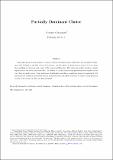Files in this item
Partially dominant choice
Item metadata
| dc.contributor.author | Gerasimou, Georgios | |
| dc.date.accessioned | 2016-03-17T00:01:09Z | |
| dc.date.available | 2016-03-17T00:01:09Z | |
| dc.date.issued | 2016-01 | |
| dc.identifier | 170507044 | |
| dc.identifier | 28130b16-fe8c-45d0-a598-55831226636d | |
| dc.identifier | 84955203909 | |
| dc.identifier | 000373304900005 | |
| dc.identifier.citation | Gerasimou , G 2016 , ' Partially dominant choice ' , Economic Theory , vol. 61 , no. 1 , pp. 127-145 . https://doi.org/10.1007/s00199-015-0869-8 | en |
| dc.identifier.issn | 0938-2259 | |
| dc.identifier.other | ORCID: /0000-0003-3712-3154/work/59698749 | |
| dc.identifier.uri | https://hdl.handle.net/10023/8427 | |
| dc.description.abstract | This paper proposes and analyzes a model of context-dependent choice with stable but incomplete preferences that is based on the idea of partial dominance: An alternative is chosen from a menu if it is not worse than anything in the menu and is also better than something else. This choice procedure provides a simple explanation of the attraction/decoy effect. It reduces to rational choice when preferences are complete in two ways that are made precise. Some preference identification and choice consistency properties associated with this model are analyzed, and certain ways in which its predictions differ from those of other recently proposed models of the attraction effect are also discussed. | |
| dc.format.extent | 435734 | |
| dc.language.iso | eng | |
| dc.relation.ispartof | Economic Theory | en |
| dc.subject | Incomplete preferences | en |
| dc.subject | Partial dominance | en |
| dc.subject | Attraction/decoy effect | en |
| dc.subject | Rational choice | en |
| dc.subject | Context dependence | en |
| dc.subject | HB Economic Theory | en |
| dc.subject | BDC | en |
| dc.subject | R2C | en |
| dc.subject.lcc | HB | en |
| dc.title | Partially dominant choice | en |
| dc.type | Journal article | en |
| dc.contributor.institution | University of St Andrews. School of Economics and Finance | en |
| dc.identifier.doi | 10.1007/s00199-015-0869-8 | |
| dc.description.status | Peer reviewed | en |
| dc.date.embargoedUntil | 2016-03-17 |
This item appears in the following Collection(s)
Items in the St Andrews Research Repository are protected by copyright, with all rights reserved, unless otherwise indicated.

